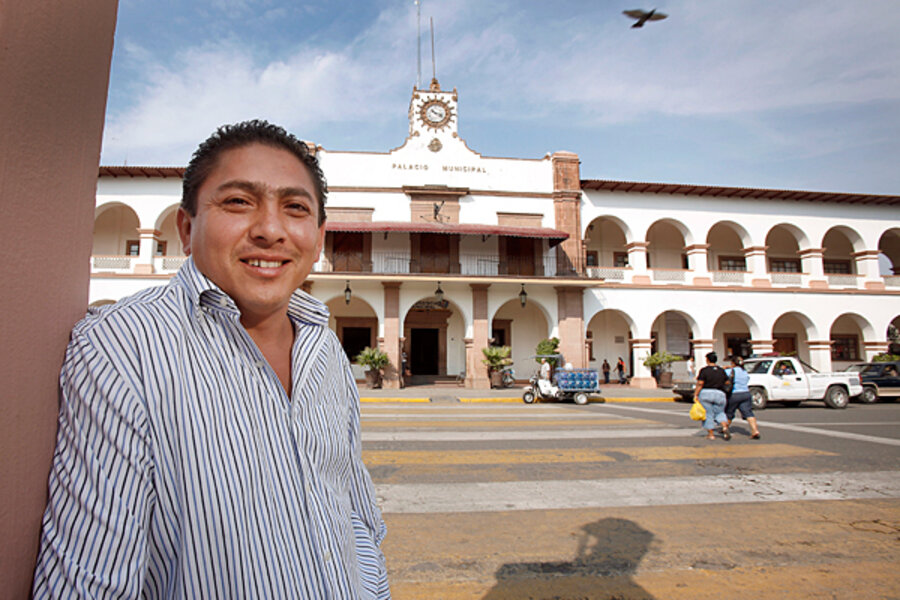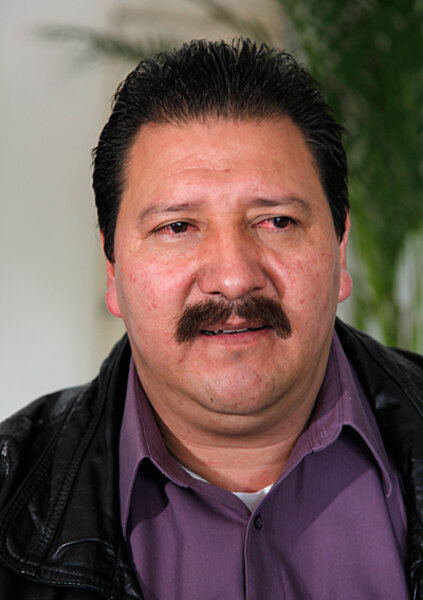Halting drug war corruption: What Mexico can learn from Colombia
| Apatzingan, Mexico; and Bogotá, Colombia
The town hall in the sweltering city of Apatzingan, Mexico, bustles with life. Residents file past colorful murals to contest fines and retrieve paperwork; bureaucrats type away in cubicles.
But that quiet efficiency once hid a nest of corruption. In May, federal police burst through the doors of the salmon-colored building in the main plaza and hauled away the mayor for alleged ties to drug traffickers in the region.
Now the next in line holds the job. “We have to look toward the future now,” says J. Guadalupe Jaimes Valladares, Apatzingan’s new mayor. “I know that I’m clean.”
Is Mr. Valladares the vanguard of a new Mexico, or simply a new chapter in an old cycle of order and corruption?
The arrest was part of a sweep that saw about a dozen mayors and nearly two dozen other local officials across the state of Michoacán, one of the most volatile in Mexico, sacked for allegedly covering for drug traffickers. The coordinated arrests were hailed as proof of Mexican President Felipe Calderón’s commitment to rooting out pervasive organized crime.
But today, the May raid is criticized by some as a publicity stunt, not part of a bold, long-term plan to clean house. And as Mexico struggles to contain ever-more-powerful traffickers, analysts say it could adopt lessons from Colombia.
No one is claiming that Colombia has vanquished its drug cartels or stopped them from corrupting government officials. But its practices may provide a useful guide to Mexico’s own battles.
For example, says Edgardo Buscaglia, an organized-crime expert and professor at Mexico’s Autonomous Institute of Technology, Colombia has gone after the drug lords – and their assets. “Regardless of how many thousands of organized crime members you detain, the end result will always be determined by how much of the economic structure of organized crime you destroy,” he says. “This is exactly what you’ve seen in Colombia in the past five years.… In Mexico, nothing like that has even started.”
Colombia revamped its anticorruption office in 2003, and President Álvaro Uribe named an anticorruption czar. This czar oversees bidding processes for government contracts and organizes workshops for officials at local levels on how to fight corruption. Perhaps most important, the country has gone after crime lords’ assets through a 2002 law that places the burden of proof on those suspected of illegal enrichment, letting authorities confiscate assets while investigations are carried out.
Mr. Buscaglia says that in the past four years, $11 billion in assets has been confiscated in Colombia. That dwarfs efforts in Mexico, he says, where a similar but weaker law was recently passed.
Of the three Latin American countries (Mexico, Guatemala, Colombia) where drug traffickers have taken over parts of the state, Colombia is generally considered the most infiltrated, according to Jorge Luis Garay, a Colombian economist who conducted a study comparing organized crime in the three nations.
Corruption follows three stages
Mr. Garay has identified three stages of state infiltration by traffickers. The first is bribing low- and mid-level government and judicial officials and police. “But bribes to specific officials do not generate long-term effects,” Garay wrote in a summary of his study. A second stage is when drug trafficking groups routinely seek to compromise high-level officials such as the heads of security agencies or police chiefs. A third phase is when drug lords try to “capture or co-opt” local and national legislative bodies, as is the case in Colombia. “That strategy has given them access to the formulation, regulation, and application of laws that have long-lasting effects,” Garay wrote.
By promising to end a vicious terror campaign of car bombings and assassinations, for example, Pablo Escobar managed to get the writers of the new Constitution in 1991 to ban extradition, though it was reinstated six years later.
But Colombia is tackling this third stage in the wake of its “parapolitics” scandal, which found that many members of Congress were colluding with paramilitaries. The country’s 30-year battle against criminal drug lords is complicated by politically motivated guerrilla insurgencies. President Uribe cracked down on guerrillas and brought a sense of peace to the war-torn nation. But he also negotiated the demobilization of right-wing paramilitary groups from 2003 to 2005 that controlled a large part of the drug-trafficking business and had a corrupting influence on politics. Confessions of their leaders have revealed an alarming level of infiltration in the top levels of politics, security agencies, and the economy.
Today, 27 percent of the members of Congress elected in 2006 are under investigation or have been convicted of colluding with paramilitaries. In many cases they signed electoral pacts that assured the militias’ influence in drafting legislation.
Colombian anticorruption czar, Oscar Ortiz, says the historic tolerance for corruption is waning. “In many ways the politicians and government officials corrupted the ‘mafiosos’ because they showed them how to put the system at their service,” he says. “No one brags anymore about running contraband or smuggling drugs,” he says, though he admits that there is still broad admiration for those who can make a quick fortune.
Claudia Lopez, a researcher in Colombia whose work helped un-cover links between politicians and paramilitaries, says that after the parapolitics scandal, pacts with candidates in next year’s congressional elections are unlikely. “That route has been burned,” she says.
Long traditions of corruption
Colombia and Mexico have long traditions of corruption, creating a permissive atmosphere for trafficking and organized crime, says Francisco Thoumi, an economist in Colombia who studies drug trafficking’s economic and social impact.
Like Colombia’s Uribe, President Calderón has made security a cornerstone of his presidency, launching a military-led crackdown on drug traffickers upon taking office in December 2006. He has promised a two-pronged approach – to root out corruption as well – by retraining the police and revamping the justice system. But if the crackdown in Michoacán, Calderón’s home state, is the leading edge of his effort, it’s failing, say critics.
Reginaldo Sandoval, the president of the Labor Party in Michoacán and a critic of Calderón, says traffickers continue to corrupt politicians, especially in the form of campaign financing. “The power they have is incredible,” says Mr. Sandoval. “Politics here is completely contaminated.”
Traffickers also wield influence through intimidation, not just with their deep pockets.
Sandoval himself was briefly kidnapped in June 2008, when gunmen burst into party headquarters posing as federal police. “When I asked to see their badges, they pulled out their guns,” Sandoval says. He was blindfolded and held for 16 hours – until his family paid a ransom – and warned to keep a low profile.
It is still unclear if drug gangs will follow the same stages in Mexico as they have in Colombia. “The evolution of corruption is difficult to predict,” says Mr. Thoumi. And as someone once quipped, he adds, there’s a major difference between the two nations: “In Colombia, drug traffickers want to become politicians; in Mexico, politicians want to become drug traffickers.”
Many Mexicans suspect official corruption goes deeper than has been made public, and the sweep in Michoacán only hints at how many politicians moonlight for organized crime. Many suspect the government has not launched sweeps in other troubled states because the state wouldn’t be able to handle the aftermath. “[Michoacán] is just the tip of the iceberg,” says Pedro Isnardo de La Cruz, a security expert at National Autonomous University of Mexico.
According to a study by Buscaglia, organized crime – including drug smuggling, prostitution, and two dozen other areas – affects 63 percent of Mexico’s municipalities.
In Michoacán, for now, the traffickers seem to be co-opting local politicians. “Michoacán is not a failed state, but it’s a state where there is dual sovereignty,” says George Grayson, an author of the new book “Mexico: Narco-Violence and a Failed State? “You have the elected governments; parallel to that, you have the cartels.”






